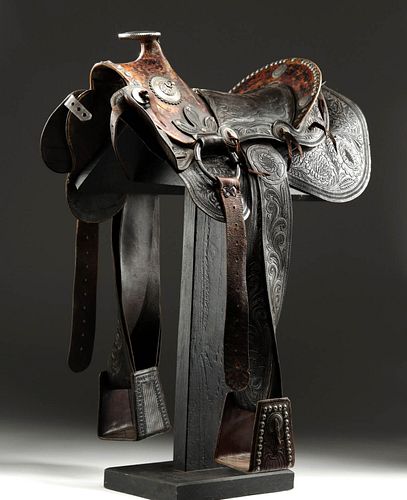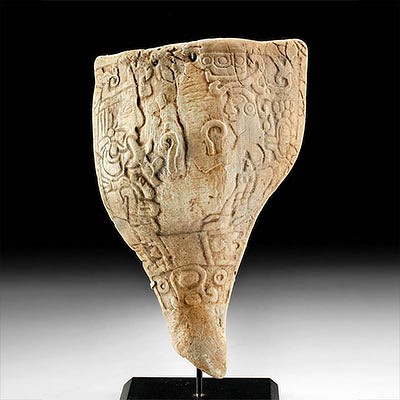19th C. Mexican Leather Saddle w/ Silver Pommel
Lot 93
About Seller
Artemis Fine Arts
686 S Taylor Ave, Ste 106
Louisville, CO 80027
United States
Selling antiquities, ancient and ethnographic art online since 1993, Artemis Gallery specializes in Classical Antiquities (Egyptian, Greek, Roman, Near Eastern), Asian, Pre-Columbian, African / Tribal / Oceanographic art. Our extensive inventory includes pottery, stone, metal, wood, glass and textil...Read more
Categories
Estimate:
$12,000 - $15,000
Absentee vs Live bid
Two ways to bid:
- Leave a max absentee bid and the platform will bid on your behalf up to your maximum bid during the live auction.
- Bid live during the auction and your bids will be submitted real-time to the auctioneer.
Bid Increments
| Price | Bid Increment |
|---|---|
| $0 | $25 |
| $300 | $50 |
| $1,000 | $100 |
| $2,000 | $250 |
| $5,000 | $500 |
| $10,000 | $1,000 |
| $20,000 | $2,500 |
| $50,000 | $5,000 |
| $100,000 | $10,000 |
| $200,000 | $20,000 |
About Auction
By Artemis Fine Arts
Oct 15, 2020
Set Reminder
2020-10-15 12:00:00
2020-10-15 12:00:00
America/New_York
Bidsquare
Bidsquare : Art of the Americas - Ancient to Present
https://www.bidsquare.com/auctions/artemis-gallery/art-of-the-americas---ancient-to-present-5840
Ancient and ethnographic art from cultures encompassing the Americas - Pre-Columbian, Native American, Northwest Coast, Spanish Colonial, more. All legally acquired, all legal to sell, all guaranteed to be as described or your money back. Convenient in-house shipping! Artemis Fine Arts info@artemisgallery.com
Ancient and ethnographic art from cultures encompassing the Americas - Pre-Columbian, Native American, Northwest Coast, Spanish Colonial, more. All legally acquired, all legal to sell, all guaranteed to be as described or your money back. Convenient in-house shipping! Artemis Fine Arts info@artemisgallery.com
- Lot Description
North America, Mexico, ca. mid 19th century CE. A gorgeous, ornately tooled leather Charro saddle, bearing the label "J. Warmuth y Co., Mexico". Engraved overlaid silver conchos give the piece a Classical influence - large bosses bearing a wild bearded face surrounded by grapes that looks like the Greco-Roman figure of Silenus, companion of Dionysus/Bacchus, while the front of the saddle is studded with silver discs bearing lion heads. The top of the horn has a silver disc with concentric circles. Further tiny silver discs with inlaid pearl stud the back of the saddle and the edges of the stirrups. Ornate floral and leaf motifs decorate the rest of the saddle, which also features dangling squared-off stirrups. Size: 13.5" L x 26" W x 33" H (34.3 cm x 66 cm x 83.8 cm); silver ranges in quality from sterling to 50%.
The charro is a traditional Mexican horseman, the result of hundreds of years of blended indigenous and Spanish Colonial culture. After the conquest of Mexico, the Viceroyalty of New Spain prohibited indigenous people from riding or using horses aside from certain elite members of indigenous groups that had allied with the Spanish. However, as cattle became an important part of the Mexican economy, land owners needed horse riders to manage their herds. Farmers hired mestizo cowboys, who had to obey several laws in order to be allowed to ride a horse, including that they had to use a saddle different from that used by the Spanish military. From these first riders, horse riding grew in popularity, especially after the Mexican War of Independence (1810-1821). After the war, Mexico was in chaos, and some horsemen began dressing themselves in silver-adorned finery and dressing in the distinctive clothing of "charros" - elite horse riders with large sombreros, tight trousers, and embroidered jackets. Towards the end of the 19th century, President Benito Juarez established a group of mounted police known as the "rurales" to establish order in the countryside, and they drew upon the look and style of the "charros", coming to symbolize national unity, strength, and the ideal of Mexican manhood. Perhaps the most famous charro is General Emiliano Zapata. Today, the charro lives on in the national sport of Mexico, the "charreada" or Mexican rodeo.
Provenance: private Glorieta, New Mexico, USA collection, purchased in Mexico City, Mexico
All items legal to buy/sell under U.S. Statute covering cultural patrimony Code 2600, CHAPTER 14, and are guaranteed to be as described or your money back.
A Certificate of Authenticity will accompany all winning bids.
We ship worldwide and handle all shipping in-house for your convenience.
#149500Stand in photograph not included. Wear commensurate with age including some cracking/tearing of the leather, especially in areas where it would natural wear as on the seat and underside. Some small losses to the silver buttons and decorations but most are present. Overall in very nice condition and well maintained with clear motifs.Condition
- Shipping Info
-
All shipping is handled in-house for your convenience. Your invoice from Artemis Gallery will include shipping calculation instructions. If in doubt, please inquire BEFORE bidding for estimated shipping costs for individual items.
-
- Buyer's Premium



 EUR
EUR CAD
CAD AUD
AUD GBP
GBP MXN
MXN HKD
HKD CNY
CNY MYR
MYR SEK
SEK SGD
SGD CHF
CHF THB
THB


















